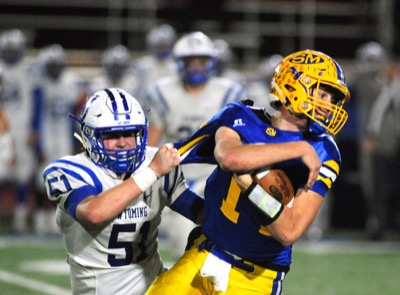Monday, November 26th, 2018
Latest technology boosts efficiency, safety of officers
By Tom Stankard

Photo by Dan Melograna/The Daily Standard
Deputy Jason Seger uses the laptop computer in his cruiser recently. Advancements in crime-fighting technology give members of law enforcement better access to information.
CELINA - Technology in their cars has made law enforcement officers safer and more effective.
Looking back on how the technology has improved, Mercer County Sheriff Jeff Grey recalled a conversation he had with former Pickaway County Sheriff Dwight Radcliff, who was in law enforcement before two-way radios were installed in police cars.
"He said there were poles with lights on them. The dispatchers flicked on (the lights) if they got a call. When deputies were patrolling, they had to go to the poles every so often," Grey said. "If a light was on they went to a pay phone to call the dispatcher and find out what the call was about."
Now, computers inside the cruisers allow deputies to run license plates and drivers' licenses, Grey noted, and added the Global Positioning System enables dispatchers to track the deputies' locations.
Digital cameras installed in modern vehicles record arrests, providing a defense for officers.
"Sometimes you get people who will bang their head on the cage," he said. "When they have injuries, they say 'the cops did it.' Now we have them on video."
Rockford Police Chief Paul May recalled one of his cars before the digital age had VHS cameras.
"We had to change the tapes every six hours or so," he said. "We had stacks and stacks of boxes filled with the tapes in the office. No one ever came to look at them."
St. Henry Police Chief Bob Garman said he prefers not to use computers, noting he fills out paperwork between traffic stops and handwrites tickets instead of printing them out on a computer.
Former Celina Assistant Police Chief Calvin Freeman recalled that a cruiser with a sole rotating beacon light that was difficult to see in bad weather.
"Snow, rain and fog made it hard for oncoming traffic to see us," he said. The beacon was nothing like the powerful LED light bars that adorn modern cars, he added.
May said the beacon light drained the battery, but the LED bar is more energy efficient and is more visible.
Vehicles can be designed to accommodate a K-9. Grey said the vehicles have equipment to send a text message to the dog's handler if the vehicle gets too hot for the dog inside. The windows also automatically roll down, and fans installed near the windows turn on to prevent the dog from overheating.
To help prevent theft, Grey said his office's cars are equipped technology allowing a deputy to remove the keys from the ignition but keep the engine running with a push of the button.
"If somebody tries to steal the car, you can't put it in drive, so you can't steal it," he said. "When the deputy gets back in, he or she puts the key back in the ignition, and it unlocks everything."
Over the years, Grey recalled law enforcement has been behind the wheel of various models from the big three - the Chevrolet Caprice, Ford Crown Victoria and modern Dodge Charger.
"My favorite were the Chevrolet Caprices. They had lots of room and were fast," Grey noted.
Garman agreed, saying "I always thought the Caprice was the best."
Looking back, May said he liked the Crown Victorias because they had lots of room, compared with the modern Charger, commenting that driving one of those feels like being in a coffin.
Grey said his department has gradually been replacing the Chargers with Ford sport utility vehicles.
"They seem to hold up pretty well, get 20 miles per gallon and are all-wheel drive. That's a big help in the wintertime with the snow and stuff," he said.
Grey said he doesn't know how technology will develop over the next 10 years but hopes it will continue to make deputies' lives safer and easier.


